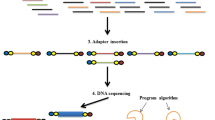Abstract
Microorganisms are essential to maintain ecosystem functions and health as they catalyze most keystone processes. Formerly the quantification of key functions was performed by broad ranged primers, which were mainly based on genomes of cultivated microbes. To take advantage of the enormous development of next generation sequencing technologies, we propose to use metagenomic data for the design of new primer systems. Here we describe a two-phasic approach for a targeted and site specific primer design for qPCR.
Similar content being viewed by others
Literatur
Sandifer PA, Sutton-Grier AE, Ward BP (2015) Exploring connections among nature, biodiversity, ecosystem services, and human health and well-being: opportunities to enhance health and biodiversity conservation. Ecosyst Serv 12:1–15
Bosch TCG, McFall-Ngai MJ (2011) Metaorganisms as the new frontier. Zoology 114:185–190
Levy M, Thaiss CA, Elinav E (2015) Metagenomic cross-talk: the regulatory interplay between immunogenomics and the microbiome. Genome Med 7:1–13
van Dijk EL, Auger H, Jaszczyszyn Y et al. (2014) Ten years of next-generation sequencing technology. Trends Genet 30:418–426
Baas Becking LGM (1934) Geobiologie of inleiding tot de milieukunde. Van Stockum & Zoon, Den Haag
Wei W, Isobe K, Nishizawa T et al. (2015) Higher diversity and abundance of denitrifying microorganisms in environments than considered previously. ISME J 9:1954–1965
Schöler A, de Vries M, Vestergaard G et al. (2016) Reconstruction of transformation processes catalyzed by the soil microbiome using metagenomic approaches. In: Martin F, Uroz S (Hrsg) Microbial Environmental Genomics (MEG). Springer, New York, 197–206
de Vries M, Schöler A, Ertl J et al. (2015) Metagenomic analyses reveal no differences in genes involved in cellulose degradation under different tillage treatments. FEMS Microbiol Ecol 91 (doi: 10.1093/femsec/fiv069)
Henrissat B (1991) A classification of glycosyl hydrolases based on amino acid sequence similarities. Biochem J 280:309–316
Berlemont R, Martiny AC (2013) Phylogenetic distribution of potential cellulases in bacteria. Appl Environ Microbiol 79:1545–1554
Bergkemper F, Schöler A, Engel M et al. (2015) Phosphorus depletion in forest soils shapes bacterial communities towards phosphorus recycling systems. Environ Microbiol, doi: 10.1111/1462-2920.13188
Ragot SA, Kertesz MA, Bünemann EK (2015) phoD alkaline phosphatase gene diversity in soil. Appl Environ Microbiol 81:7281–7289
Sakurai M, Wasaki J, Tomizawa Y et al. (2008) Analysis of bacterial communities on alkaline phosphatase genes in soil supplied with organic matter. Soil Sci Plant Nutr 54:62–71
Marchler-Bauer A, Derbyshire MK, Gonzales NR et al. (2015) CDD: NCBI’s conserved domain database. Nucleic Acids Res 43:222–226
Dieffenbach CW, Lowe TMJ, Dveksler GS (1995) General concepts for PCR primer design. In: Dieffenbach CW, Dveksler GS (Hrsg) PCR Primer, A Laboratory Manual. Cold Spring Harbor Laboratory Press, New York, 133–155
Author information
Authors and Affiliations
Corresponding author
Additional information
Fabian Bergkemper, Stefanie Schulz, Maria de Vries, Anne Schöler und Michael Schloter (v. l. n. r.)
Die Abteilung für Umweltgenomik unter der Leitung von Prof. Dr. Michael Schloter untersucht Mikrobiome in unterschiedlichen Umweltkompartimenten und versucht aus den Daten ökologische Gesetzmäßigkeiten der Interaktionsmuster abzuleiten. Im Fokus sind dabei Interaktionen zwischen Mikroorganismen und dem Menschen (AG Dr. Anne Schöler) und der Pflanze (AG Prof. Dr. Schröder) sowie Mikrobiomstrukturen in Böden (AG Dr. Stefanie Schulz).
Rights and permissions
About this article
Cite this article
Schulz, S., Bergkemper, F., De Vries, M. et al. qPCR zur quantitativen Validierung von Metagenomdaten. Biospektrum 22, 265–269 (2016). https://doi.org/10.1007/s12268-016-0684-1
Published:
Issue Date:
DOI: https://doi.org/10.1007/s12268-016-0684-1




